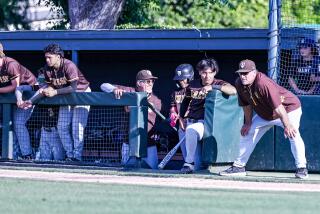Romancing the Stones : Handful of Works at Irvine Museum Catch Spirit of the Missions
- Share via
IRVINE — Ever since the English invented the idea of the “picturesque” in the late 18th Century, people have fallen under the spell of aging, ramshackle architecture and overgrown gardens as embodiments of the iron whim of nature. In California, where old is a relative term, the Spanish missions--conveniently established at the dawn of the Romantic era--easily filled the bill.
“Romance of the Bells: The California Missions in Art,” at the Irvine Museum through Oct. 14, offers a lengthy tour of the state’s missions via paintings and etchings from the 19th and early 20th centuries.
Unless the viewer has an overwhelming interest either in the missions or the painters, the show may seem rather tedious--a situation that isn’t helped by the inclusion of too many canvases with paint-by-numbers brushwork or cloyingly sentimental imagery.
But here and there are quiet pleasures, several depicting the most famous of the 21 Spanish colonial real-estate and proselytizing enterprises, Mission San Juan Capistrano.
Founded in 1776 in “a very pleasant green valley”--as Father Juan Crespi wrote on a summer scouting expedition a few years earlier--the mission eventually boasted 74 adobe buildings and a seven-domed cathedral with a bell tower.
The mission didn’t become properly “picturesque” until the earthquake of 1812, which destroyed the church. Poor harvests, a drop-off in religious conversions, a pirate raid and the fallout (secularization, lack of upkeep) from Mexico’s 1821 break from Spanish rule helped the mission sag even further into evocative decay.
Yet the conveniently located town of San Juan Capistrano prospered in the late 19th Century, aided by the arrival of the railroad in 1887. Among the increasingly frequent visitors were artists intrigued by the derelict mission, by then a home for birds and stray animals.
Civic leaders eventually cleaned up the site, stabilized the buildings and planted a garden. One early 20th-Century visitor, Father St. John O’Sullivan, took it upon himself to spruce up Father Junipero Serra’s chapel and hire John Gutzon Borglum--decades before he embarked on his Mt. Rushmore project--to carve a statue of the mission’s founder.
Borglum is represented in the show by “Sheep Grazing, Mission Capistrano,” an Arcadian image bathed in golden light with a phantom shepherd the artist didn’t quite succeed in banishing from the finished picture.
Artists have always been known for adjusting material facts to suit their interests and talents. While the academic 19th-Century artists generally dwelt on anecdotal scenes of the imagined past or indulgently viewed present, the plein-air contingent were dedicated to on- the-spot optical reportage. Yet even in this pursuit, as every photographer knows, there is plenty of wiggle room.
In the hands of Franz A. Bischoff, who specialized in flower paintings, the mission walls became a bland backdrop for a vivacious bed of hollyhocks and geraniums (“San Juan Capistrano Mission Yard”).
Alson S. Clark, on the other hand, was specifically interested in the mass and surface of buildings. He lovingly evoked the dry texture of old sunbaked adobe brick (“Ruins of San Juan Capistrano”) and studied the way colored light transformed the space between an archway (“San Juan Capistrano”).
Joseph Kleitsch, another well-known plein-air painter, had it both ways. Intrigued by the long views possible from under the mission’s arches (“The Cloisters, San Juan Capistrano”), he also lavished buoyantly airy brushwork on the leafy garden greenery (“San Juan Capistrano”).
Arthur G. Rider reflected his training under Spanish Impressionist Joaquin Sorolla by rendering sun-kissed flowers as small bursts of high-keyed color. He also turned his sights on the mission itself. But for him, architecture was mainly a pretext to show the tricks sunlight plays in painting a wall buttercup yellow (“Capistrano Ruins”).
Even a cursory tour of the show reveals how the missions conveniently dovetailed with the 19th-Century Romantic view of nature, to which the 20th-Century California plein-air painters (unlike their Modernist colleagues) remained doggedly faithful. Even in their spruced-up condition, the old buildings and secluded gardens constituted a ready-made poetic way-station awaiting the touch of a brush.
* “Romance of the Bells: The California Missions in Art,” through Oct. 14, Irvine Museum, 18881 Von Karman Ave., 12th floor, Irvine. Hours: 11 a.m. to 5 p.m., Tuesday through Saturday. Free. (714) 476-2565.
More to Read
The biggest entertainment stories
Get our big stories about Hollywood, film, television, music, arts, culture and more right in your inbox as soon as they publish.
You may occasionally receive promotional content from the Los Angeles Times.










